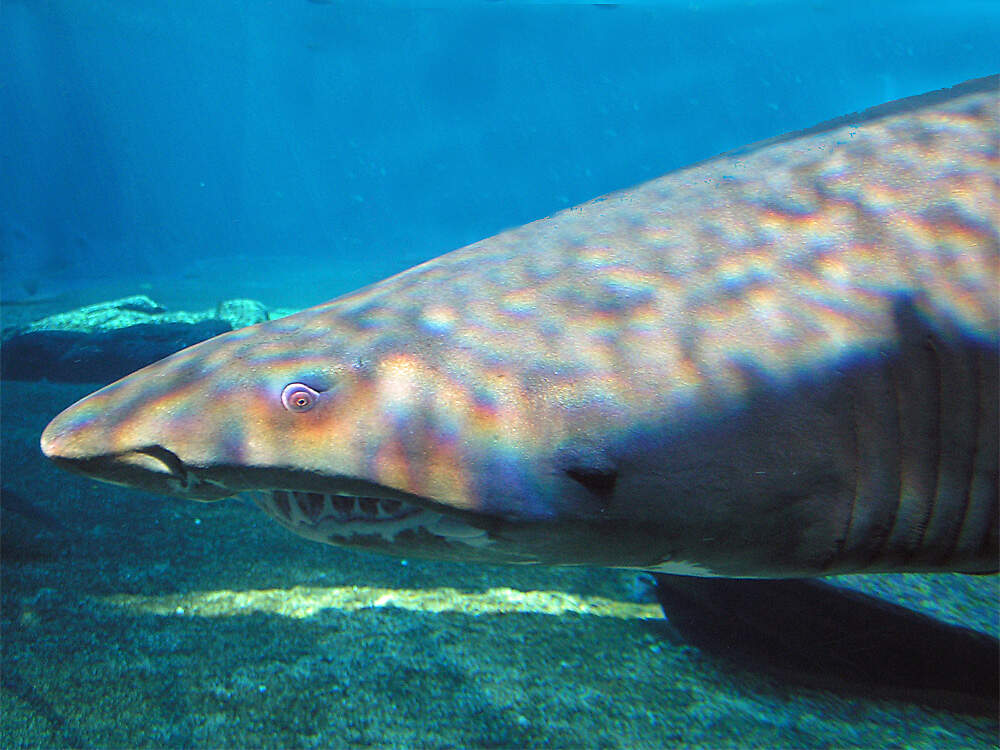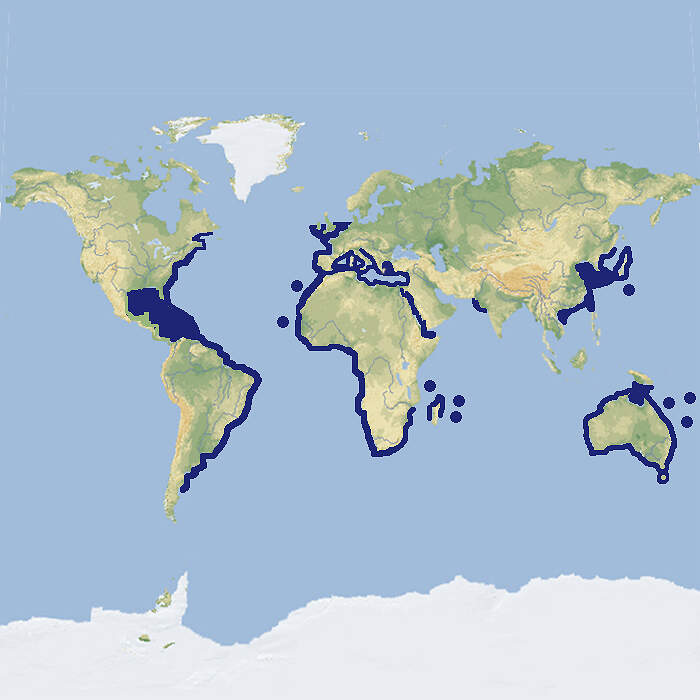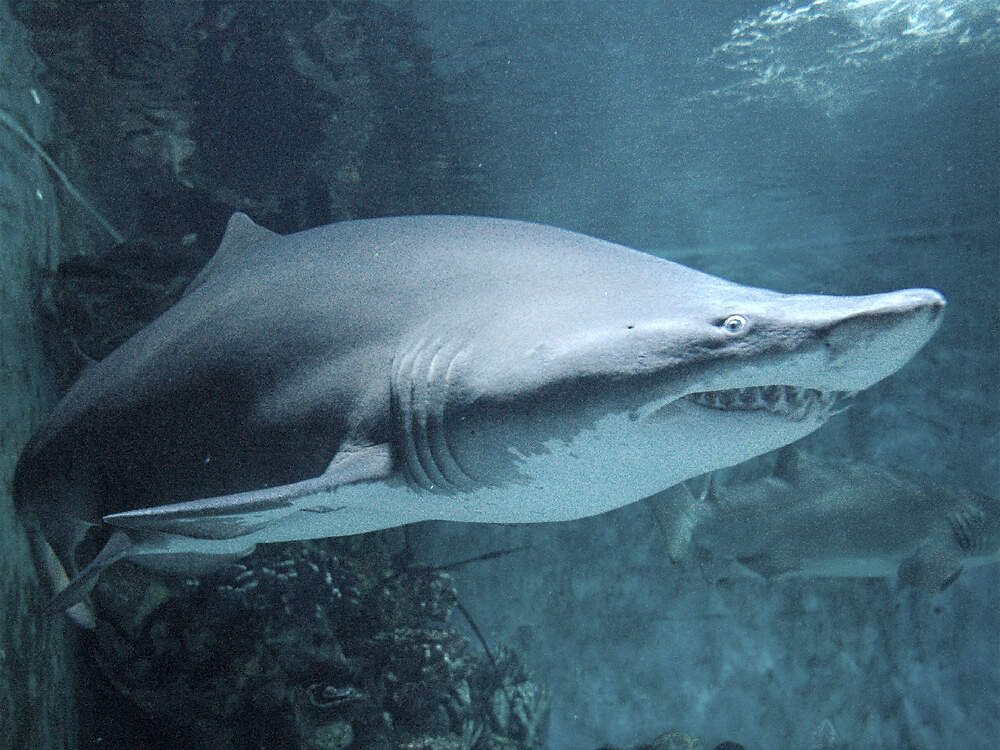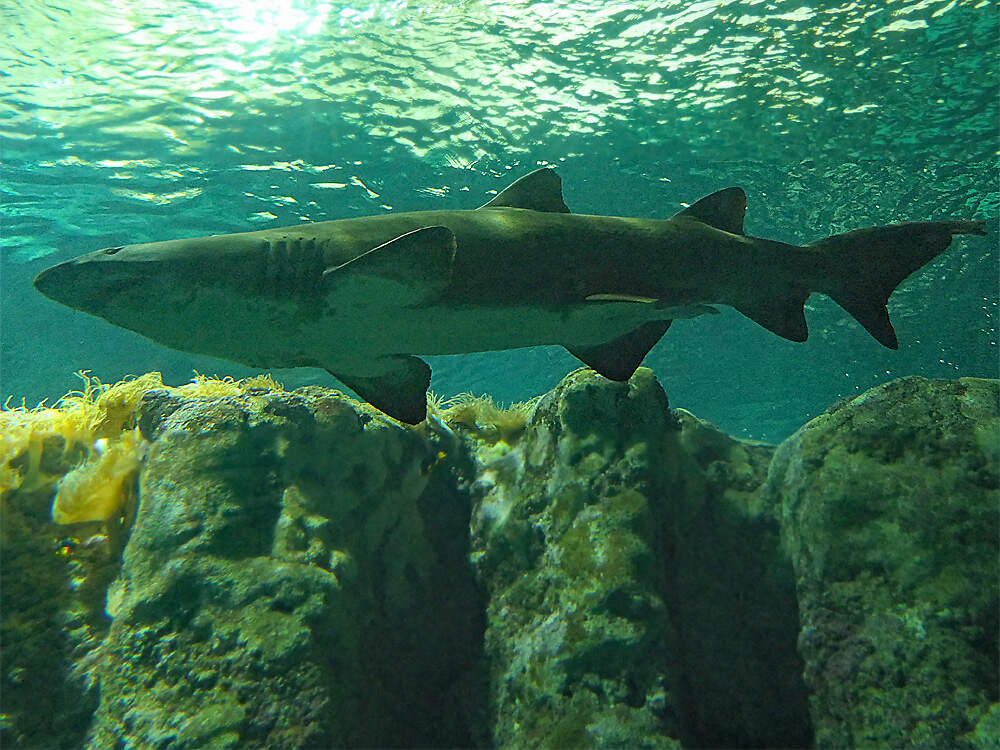BECKMANN-DAHL, R. (2019)
The Sandy Zebra Shark: A New Color Morph of the Zebra Shark Stegostoma tigrinum, with a Redescription of the Species and a Revision of Its Nomenclature.
Copeia, 107(3):524-541 (2019). https://doi.org/10.1643/CG-18-115
Abstract:
The Zebra Shark, in recent years known as Stegostoma fasciatum (Hermann, 1783), is well known for its dramatic ontogenetic change of color pattern, from striped (“zebra”) juveniles to spotted (“leopard”) adults. Nevertheless, many aspects of the species' biology, ecology, and morphology are still unknown or inadequately described, and its nomenclature is contentious. This study introduces a hitherto undescribed color morph of the Zebra Shark and provides an updated diagnosis and redescription of the species. Firstly, we establish that the Zebra Shark remains a single species based on genetic data from mitochondrial COI and ND4 markers. Secondly, through morphological analyses, we conclude that there are two morphs of the species, the known, zebra striped morph and a new, sandy colored morph. Both morphs were studied morphometrically to expose any ontogenetic changes, such as a decrease in the relative length of the tail with increasing total length (TL). The external coloration pattern clearly differentiates the two morphs, and both morphs can be further divided into three stages based on color pattern and size: juveniles (255–562 mm TL), transitionals (562–1395 mm TL), and adults (>1300 mm TL). The transitional sandy morph is dorsally covered by a swirly pattern of thin, dark brown bands edged with freckle-like brown spots. The adults are a uniform sandy beige, partially covered with brown freckles. A mature male of the zebra morph displayed a yet unknown feature of the claspers: a small, triangular spike extruding from the dorsal terminal of the clasper glands. Finally, we reviewed the nomenclature of the species and suggest that the original name Stegostoma tigrinum Forster, 1781, should be used as the senior synonym for the species.
beckmann-biblio
MOHAN, P. J., CLARK, S. T. & SCHMID, T. H. (2004)
Age and Growth of Captive Sharks.
In: SMITH, M. et al. (2004) The Elasmobranch Husbandry Manual: Captive Care of Sharks, Rays and their Relatives: 201-226. ISBN-13: 978-0-86727-152-3
Abstract:
Understanding the relationship between food intake and growth in elasmobranchsfacilitates the establishment of appropriate diets, health management protocols, andcollection plans. The Von Bertalanffy growth function (VBGF) is an appropriate method forestimating age and growth parameters. Comparisons between actual captive measurementsand mass predictions based on length-weight equations for wild sharks are useful whendetermining the condition (Wr) of aquarium-held sharks.
mohan-biblio
HENNINGSEN, A. D., SMALE, M. J., GORDON, I., GARNER, R., MARIN-OSORNO, R. & KINNUNEN, N. (2004)
Captive Breeding and Sexual Conflict in Elasmobranchs.
In: SMITH, M. et al. (2004) The Elasmobranch Husbandry Manual: Captive Care of Sharks, Rays and their Relatives: 237-248. ISBN-13: 978-0-86727-152-3
Abstract:
Successful reproduction has been recorded in many different species ofcartilaginous fish held in captivity, representing the various reproductive modes recordedin chondrichthyans. Documentation of behaviors of captive chondrichthyans has provideda foundation to our knowledge of reproductive behavior, as these interactions are rarelywitnessed in the wild and difficult to infer from freshly caught wild specimens. Reproductivebehavior often results in conspecific and interspecific conflicts. Conspecific sexual conflictmay be consexual as well as intersexual. Although specific reproductive behaviors have been reported for many species, mating systems remain poorly understood. Captivebreeding may reduce pressure on wild populations, particularly for those species wheresevere declines have been documented. Such efforts may be opportunistic, directed, orundertaken in collaboration with other institutions. Detailed behavioral records relevant toreproduction should be collected and maintained for all captive elasmobranchs and sharedthrough peer-review publication.
henningsen-biblio
KUNZE, K. & SIMMONS, L. (2004)
Notes on Reproduction of the Zebra Shark, Stegostoma fasciatum, in a Captive Environment.
In: SMITH, M. et al. (2004) The Elasmobranch Husbandry Manual: Captive Care of Sharks, Rays and their Relatives: 493-497. ISBN-13: 978-0-86727-152-3
Abstract:
A pair of zebra sharks (Stegostoma fasciatum) successfully reproduced in the Shark Reef exhibit, Henry Doorly Zoo. Mating behavior was similar to that described for the nurse shark (Ginglymostoma cirratum) (Klimley, 1980; Carrier et al., 1994) and chain dogfish (Scyliorhinus retifer) (Castro et al., 1988). Between September 1998 and September 2000, 80 fertile eggs were laid. Mean incubation time was 152.5±26.5 days, newborns had a mean TL of 30.2±0.8 cm, and mean weight of 92.2±14.0 grams. Increased water temperature resulted in decreased incubation time (R2=0.887, n=6).
kunze-biblio
CHAPMAN, D. D., SHIVJI, M. S., LOUIS, E., SOMMER, J., FLETCHER, H. & PRODOHL, P. A. (2007)
Virgin birth in a hammerhead shark.
Biol Lett. 2007 Aug 22; 3 (4): 425–427.
Published online 2007 May 22. doi: 10.1098/rsbl.2007.0189
Abstract:
Parthenogenesis has been documented in all major jawed vertebrate lineages except mammals and cartilaginous fishes (class Chondrichthyes: sharks, batoids and chimeras). Reports of captive female sharks giving birth despite being held in the extended absence of males have generally been ascribed to prior matings coupled with long-term sperm storage by the females. Here, we provide the first genetic evidence for chondrichthyan parthenogenesis, involving a hammerhead shark (Sphyrna tiburo). This finding also broadens the known occurrence of a specific type of asexual development (automictic parthenogenesis) among vertebrates, extending recently raised concerns about the potential negative effect of this type of facultative parthenogenesis on the genetic diversity of threatened vertebrate species.
chapman-biblio
TIMM, L. L., CARTER, J. E., FREY, J., PRAPPAS, J. WELLS, R. J. D. (2014)
Birth of common shovelnose rays (Glaucostegus typus) under captive conditions.
Zoo Biology 33, (4) Juli/August 2014: 357–359. DOI: 10.1002/zoo.21145.
Abstract:
The common shovelnose ray (Glaucostegus typus) is a poorly studied species of the Rhinobatidae family that occurs throughout the Indo-West Pacific. Although common in aquariums throughout the United States, there are currently no records of captive birth events. In 2013, a female common shovelnose ray housed at the Downtown Aquarium in Houston, Texas, USA gave birth to eleven pups. Although all pups were stillborn, this event demonstrates that it is possible to breed common shovelnose rays in a controlled environment. The single female and two male common shovelnose rays at the aquarium are of sexually mature size (between 206 and 240 cm total length, TL), demonstrate mating behaviors, and provide an excellent opportunity to investigate the reproductive biology of this species. Captive environmental conditions of the birth enclosure may be useful in replicating the birthing event in order to develop a breeding program that could potentially relieve collection pressures on wild populations of guitarfish given their vulnerable status. Zoo Biol. 33:357–359, 2014. © 2014 Wiley Periodicals, Inc
JANSE, M., ZIMMERMAN, B., GEERLINGS, L., BROWN, C. & NAGELKERKE, L. A. J. (2017)
Sustainable species management of the elasmobranch populations within European aquariums: a conservation challenge.
Journal of Zoo and Aquarium Research 5(1) 2017: 172-181.
Abstract:
Elasmobranchs, including sharks and rays, are popular animals in public aquariums. Worldwide,
more than 700 million people visit zoos and aquariums annually, enabling elasmobranchs to become
an important ambassador for their natural habitats. We conducted a census within the European
Association of Zoos and Aquaria to gain a better overview of which species are present within European
collections. The census showed that 102 chondrichthyan species are found in European zoos and public
aquariums, accounting for 8.6% of all known species. Benthic species are the most common. Of the
captive population, 47.1% of species have reproduced in aquariums. Of the reproducing species, 87.8%
exhibit body sizes of 51 to 250 cm. Categorising the reproductive results by reproductive mode, the
most successful are oviparous and aplacental viviparous groups with uterine villi or trophonemata. A
regional collection plan, stating the level of organised breeding recommended within the region, has
been defined using the results of the census and the IUCN status. Currently, 42 species are managed
by a species coordinator, within the ex-situ European elasmobranch population, to ensure a genetically
healthy population, to increase reproductive output and to conduct husbandry research. Longterm
breeding efforts will help to reduce the demand on wild populations to supply the aquarium
population. Species coordinators will become the contact for in-situ conservation initiatives and
international conservation bodies like IUCN. This study discusses further the future challenges in the
captive management of chondrichthyan populations.
Sandtigerhai
Klasse: Knorpelfische (CHONDRICHTHYES)
Teilklasse: Plattenkiemer (ELASMOBRANCHII)
Taxon ohne Rang: Haie (SELACHII)
Überordnung: GALEOMORPHI
Ordnung: Makrelenhaiartige (LAMNIFORMES)
Unterordnung: Orectoloboidei
Familie: Sandtigerhaie (Odontaspididae)

Sandtigerhai
Carcharias taurus • The Sand Tiger Shark • Le requin-taureau
- Körperbau und Körperfunktionen
- Verbreitung
- Lebensraum und Lebensweise
- Gefährdung und Schutz
- Bedeutung für den Menschen
- Haltung
- Taxonomie und Nomenklatur
- Literatur und Internetquellen
|
Weitere Bilder auf BioLib.cz |
Der im Freiland gefährdete Sandtigerhai ist eine relativ oft in europäischen Zoos und Schauaquarien zu sehende mittelgroße Haiart. Körperbau und KörperfunktionenDer Sandtigerhai hat eine kurze, spitze Schnauze, kleine Augen, beidseits fünf Kiemenspalten und vorstehende, dornartige Zähne, die in mehreren Reihen angeordnet sind. Die Tiere werden mit einer Länge von rund 220 cm geschlechtsreif und können eine Länge von 350(-430) cm erreichen Mit der gelblichbraunen bis gräulichen Färbung ihrer Oberseite, die oft mit unregelmäßig verteilten braunen Flecken gezeichnet ist, sind sie außerordentlich gut dem sandigen Meerboden angepasst. Der Bauch ist heller [1; 3; 6; 7]. VerbreitungWeltumspannend, vielleicht mit Ausnahme des Ost-Pazifiks: Im Indopazifik vom Roten Meer und der afrikanischen Küste bis nach Japan, Korea und Australien einschließlich der Arafurasee zwischen Neuguinea und Nordaustralien und der Tasmansee. Im West-Atlantik vom Golf von Maine bis Argentinien einschließlich des Karibischen Meers, im Ostatlantik von der europäischen Küste und dem Mittelmeer bis Südafrika, möglicherweise mit Unterbrüchen (widersprüchliche Angaben der einzelnen Quellen) [2; 5; 6]. Lebensraum und LebensweiseDer Sandtigerhai lebt in Bodennähe der Schelfregion in Tiefen bis 200 m. Er erleichtert sein Körpergewicht, indem er Luft schluckt und sie im Magen behält, der so als eine Art Schwimmblase funktioniert. Er schwimmt ständig umher, um seine Sauerstoffversorgung zu gewährleisten, jagt aber hauptsächlich nachts. Er ernährt sich von verschiedenen Bodenfischen, fängt aber auch Tintenfische und Kraken sowie Krebstiere. Er ist lebendgebärend. Die Jungtiere schlüpfen bereits im Uterus und dezimieren sich gegenseitig, sobald der Dottervorrat aufgebraucht ist. Deshalb kommen 8-9 Monate nach der Paarung jeweils nur zwei Jungtiere - aus jedem Utrerushorn eines - zur Welt [3; 7]. Gefährdung und SchutzKommerzielle Fischerei, Sportfischen und das Verbauen von Stränden mit Schutznetzen haben gebietsweise zu einer markanten Abnahme der Bestände geführt. Die Art gilt daher aufgrund einer Beurteilung aus dem Jahr 2005 als gefährdet [5]. Der internationale Handel ist durch CITES nicht geregelt. Zoogestützte Artenschutzprojekte (Beispiele):
Bedeutung für den MenschenIn Europa kommt der Sandtigerhai zwar ins flache Wasser von Badestränden, geift aber keine Menschen an, dies im Gegensatz zur Population in Südafrika, die als für den Menschen sehr gefährlich gilt [3]. Regional, etwa in Japan, ist der Sandtiger ein begehrter Speisefisch. In Australien hat er große Bedeutung in der Sportfischerei [5]. HaltungSandtigerhaie werden gelegentlich in Aquarien gezüchtet, es gibt Zuchtberichte z.B. aus den Jahren 1993 und 1997 [4]. Haltung in europäischen Zoos: Die Art wird in rund 40 europäischen Einrichtungen gezeigt, von denen sich wenige im deutschsprachigen Raum befinden. Für Details siehe Zootierliste. Mindestanforderungen: In Deutschland und Österreich gibt es keine konkreten Mindestnormen. Die "Mindestnormen für das Halten von Fischen zu Zierzwecken" der Schweizerischen Tierschutzverordnung dürften auf Knorpelfische nicht anwendbar sein, jedoch ist für das private Halten von Haien und Rochen eine Bewilligung erforderlich. Taxonomie und NomenklaturDie Art wurde 1810 von dem in Marseille aufgewachsenen, hauptsächlich in den USA tätigen Universalgelehrten Constantine Samuel RAFINESQUE unter ihrem heute noch gültigen Namen erstmals beschrieben [2]. Literatur und Internetquellen
|
Zurück zu Übersicht Fische
Weiter zu Adlerrochen (Myliobatis aquila)
COMPAGNO, L., DANDO, M. & FOWLER, S. (2005)
Sharks of the World.
406 Seiten, mit 128 Farbtafeln, 500 Strichzeichnungen und 500 Verbreitungskarten.
Princeton Universitry Press. ISBN-13: 9780691120720.
Verlagstext
Everyone's heard of the Great Whites. But most people know little of the hundreds of other types of sharks that inhabit the world's oceans. Written by two of the world's leading authorities and superbly illustrated by wildlife artist Marc Dando, this is the first comprehensive field guide to all 440-plus shark species. Color plates illustrate all species, and detailed accounts include diagnostic line drawings and a distribution map for each species. Introductory chapters treat physiology, behavior, reproduction, ecology, diet, and sharks' interrelationships with humans.
- More than 125 original full-color illustrations for fast and accurate identification of each shark family
- Over 500 additional drawings illustrating physical features from different angles
- Clear identification information for each species with details of size, habitat, behavior, and biology
- Quick ID guide helpful for differentiating similar species
- Geographic distribution maps for each species
- For professional and amateur shark enthusiasts
VILCINSKAS, A. (2011)
Haie und Rochen. Arten - Lebensräume - Verhalten.
288 Seiten, zahlreiche Farbfotos.
Komet Verlag, Köln. ISBN 978-3-625-12097-1.
Verlagstext:
Wilde Tiere hautnah erleben: Mit atemberaubenden Farbaufnahmen der besten Tierfotografen und informativen Texten bietet dieses Buch einen umfassenden und reich bebilderten Überblick über die faszinierende Welt der Haie und Rochen.
Alles Wissenswerte über die bekanntesten und beeindruckenden Arten, ihre Lebensräume und ihr Verhalten – spannend und lehrreich zugleich!




